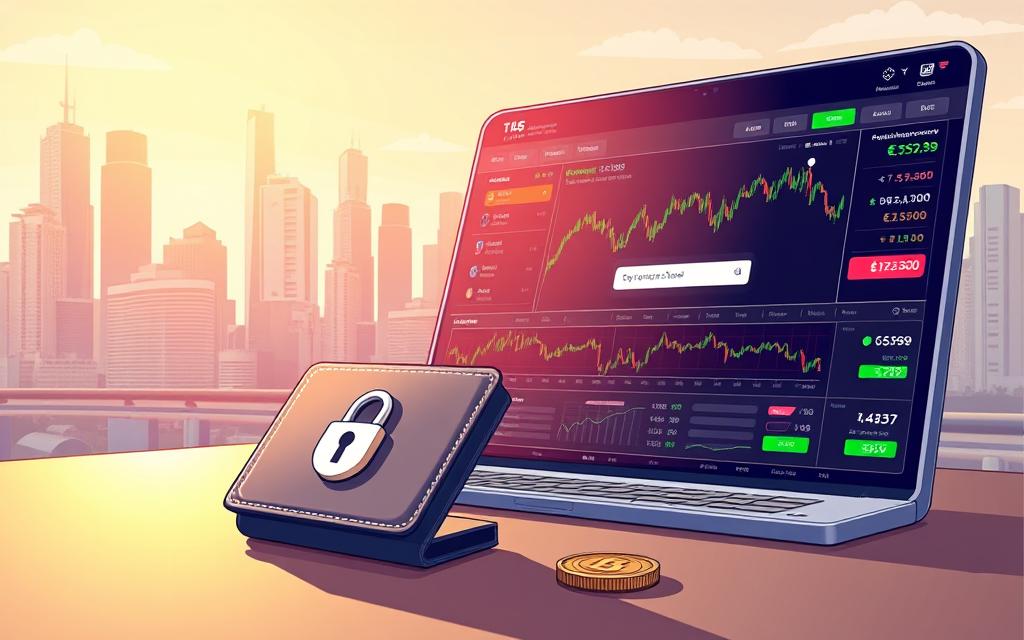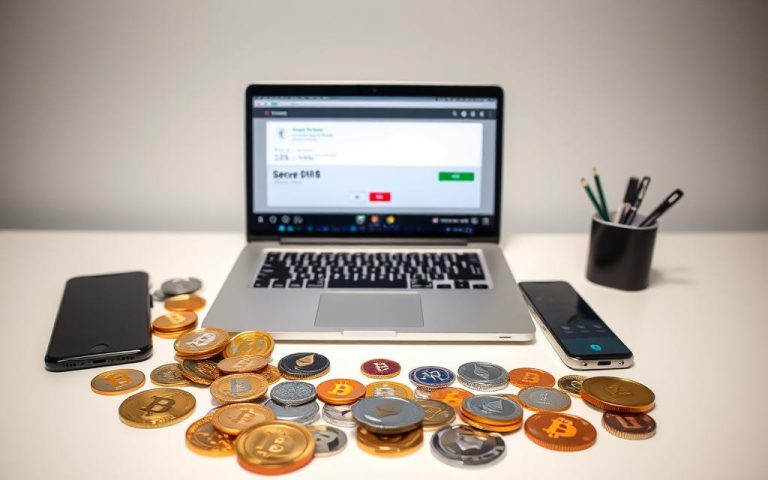Cryptocurrency 101: Everything You Need to Know
Cryptocurrency revolutionizes how people exchange value globally. Unlike traditional money, it operates on decentralized networks powered by blockchain technology. This eliminates the need for banks or governments to oversee transactions.
Bitcoin, the first crypto, introduced a peer-to-peer payment system. Ethereum expanded possibilities with smart contracts—self-executing agreements without middlemen. Over 16% of U.S. adults have used these digital assets, according to Pew Research.
The market now exceeds $2.4 trillion, showcasing rapid growth. While volatile, cryptocurrencies offer transparency and borderless transfers. This guide explores Bitcoin, Ethereum, and altcoins shaping the future of finance.
What I Need to Know About Cryptocurrency: The Basics
Digital currencies redefine financial interactions without relying on centralized institutions. These internet-native assets use blockchain technology to record transactions across a distributed network, contrasting sharply with traditional banking ledgers.
Defining Digital Currency
Cryptocurrencies are purely digital, existing as code on decentralized networks. Unlike physical cash, they enable peer-to-peer transfers without intermediaries. Blockchain ensures transparency—every transaction is publicly recorded and immutable.
For example, Bitcoin’s 21 million supply cap prevents inflation, unlike fiat currencies controlled by central banks. Mining pools handle 99% of Bitcoin blocks, showcasing collective network participation.
How Cryptocurrency Differs from Traditional Money
Traditional bank systems rely on centralized authorities to verify transactions. Cryptocurrencies automate this via consensus algorithms, eliminating third-party delays. Transactions settle in minutes and cannot be reversed, reducing fraud risks.
Banks operate within business hours, while crypto markets run 24/7 globally. However, digital currency accounts lack FDIC insurance, requiring users to manage security independently.
Peer-to-peer transfers bypass bank fees, lowering costs. Yet volatility and regulatory uncertainty remain challenges for mainstream adoption.
How Cryptocurrency Works: Blockchain Technology Explained
Blockchain technology powers every cryptocurrency transaction securely and transparently. This digital ledger records data in interconnected blocks, each cryptographically linked to the next. Once added, records cannot be altered, ensuring immutability.

The Role of Decentralization
Decentralized networks replace banks by distributing transaction validation across thousands of nodes. Each node verifies new entries against the blockchain’s history, preventing fraud. For example, Bitcoin mining pools collectively validate blocks, but no single entity controls the process.
This system resists censorship and outages. If one node fails, others maintain the network. However, 51% attacks remain a risk if a group gains majority control—though cryptographic safeguards make this impractical for large chains like Bitcoin.
Proof of Work vs. Proof of Stake
Bitcoin’s PoW requires miners to solve complex puzzles, consuming 707 kWh per transaction—more than some households use in weeks. Successful miners earn 6.25 BTC per block but face high energy costs.
Ethereum’s PoS slashed energy use by 99.95% after its 2022 upgrade. Validators “stake” coins as collateral, earning rewards (4–8% APY on chains like Cardano). This process prioritizes scalability and sustainability over raw computational power.
Both methods secure transactions but differ radically in environmental impact. PoW supports Bitcoin’s $600B+ market cap, while PoS aligns with greener technology trends.
Popular Types of Cryptocurrency
The crypto market offers diverse digital assets, each serving unique purposes. From store-of-value coins to smart contract platforms, these coins reshape global finance. Understanding their differences helps investors make informed decisions.
Bitcoin: The Pioneer
Bitcoin remains the undisputed leader with over 50% market dominance. Often called “digital gold,” its 21 million supply cap creates scarcity similar to precious metals. The network processes just 7 transactions per second, prioritizing security over speed.
Miners validate transactions through energy-intensive proof-of-work. This process maintains decentralization but consumes significant electricity. Despite this, Bitcoin’s $1.93 trillion market cap proves its staying power.
Ethereum and Smart Contracts
Ethereum revolutionized blockchain with programmable smart contracts. Its ERC-20 standard enabled 400,000+ projects, from DeFi platforms to NFT marketplaces. The network handles 1.2 million daily transactions after switching to proof-of-stake.
This upgrade reduced energy use by 99.95% while maintaining security. Validators now stake ETH instead of mining, earning 4-8% annual yields. Ethereum’s flexibility makes it the backbone of Web3 applications.
Altcoins and Their Unique Uses
Alternative coins serve specialized functions beyond payments:
| Coin | Market Cap | Primary Use | TPS |
|---|---|---|---|
| Binance Coin (BNB) | $83.4B | Exchange utility | 1,400 |
| XRP | $136.1B | Cross-border payments | 1,500 |
| Solana (SOL) | $96B | High-speed transactions | 65,000 |
| Chainlink (LINK) | $9.28B | Blockchain oracles | N/A |
Stablecoins like USDT maintain 1:1 USD pegs for less volatile trading. Memecoins such as Dogecoin show how community support can drive $23B valuations without utility. For deeper insights, explore different cryptocurrency categories.
Niche altcoins solve specific problems. Filecoin offers decentralized storage, while Polygon scales Ethereum transactions. Each project expands blockchain’s real-world applications beyond financial speculation.
Why Invest in Cryptocurrency?
Digital assets continue reshaping global finance, offering unique opportunities for investors. Unlike traditional markets, crypto provides decentralized alternatives with distinct advantages. From high-growth potential to inflation resistance, these assets attract diverse participants.

Potential for High Returns
Bitcoin delivered 150% returns in 2024 alone, outpacing most traditional investments. Historical data shows even more staggering growth—from under $0.01 to over $100,000 since 2010. This represents an annualized return of 170%, dwarfing the S&P 500’s average.
Ethereum demonstrates similar potential, rising from $0.30 to $4,000 at its peak. Such performance stems from blockchain’s expanding value propositions:
- DeFi platforms now manage $100B+ in assets
- NFT markets create new digital ownership models
- Smart contracts automate trillion-dollar industries
However, volatility remains high—82% versus 19% for stocks over five years. This risk-reward balance requires careful consideration.
Hedging Against Inflation
Bitcoin’s 21 million supply cap makes it naturally resistant to inflation. Unlike fiat currencies, no central authority can print more coins. During 2022-2024 dollar devaluation, Bitcoin maintained purchasing power better than many national currencies.
Key inflation-hedging characteristics include:
| Asset | Supply Mechanism | 5-Year Inflation Rate |
|---|---|---|
| Bitcoin | Fixed (21M) | 1.8% (mining rewards halve) |
| US Dollar | Unlimited (Federal Reserve) | 18.6% cumulative |
| Gold | ~2% annual growth | Matching money supply |
Institutional adoption confirms this thesis. BlackRock’s $10B crypto AUM includes Bitcoin ETFs attracting $50B inflows. Millennials lead this shift—34% now hold digital assets, per Schwab research.
For those exploring these opportunities, 10 compelling reasons to invest in provides deeper analysis. Remember—past performance doesn’t guarantee future results, and diversification remains crucial.
Risks and Challenges of Cryptocurrency
While cryptocurrencies offer innovation, they also present unique challenges for users and investors. The market remains highly volatile, and security vulnerabilities can lead to significant losses. Understanding these risks helps make informed decisions in this evolving space.

Market Volatility
Price swings in crypto markets dwarf traditional assets. Bitcoin frequently experiences 25% fluctuations within 30 days—five times more than major stock indices. These swings stem from speculative trading and shifting regulations.
The FTC reports over $1B lost to crypto scams in 2023 alone. Chainalysis data shows 20% of all Bitcoin has been permanently lost due to wallet access issues. Such volatility makes crypto assets unsuitable for risk-averse investors.
Security Concerns and Scams
Security breaches plague the industry, with exchange hacks like Mt. Gox ($450M) and Coincheck ($530M) making headlines. Smart contract vulnerabilities enabled the $325M Wormhole bridge exploit—one of many DeFi attacks.
Scammers increasingly use “pig butchering” schemes, stealing $75M monthly through fake investment platforms. Social media promotions with “Guaranteed Returns” often mask conflicts of interest. The SEC has escalated enforcement actions in 2024 to combat these threats.
Custodial risks emerged when Celsius Network froze withdrawals before bankruptcy. Unlike bank accounts, crypto transactions lack fraud reversal options. Once sent, funds cannot be recovered without recipient cooperation.
Environmental impacts also raise concerns. Bitcoin mining consumes 0.55% of global energy—more than many countries. While proof-of-stake reduces this footprint, energy-intensive networks remain controversial.
How to Buy and Store Cryptocurrency
Acquiring digital assets requires selecting secure platforms and storage solutions. The process involves choosing regulated exchange services and understanding different wallet types. Proper setup ensures safe transactions and asset protection.

Choosing a Cryptocurrency Exchange
Reputable exchange platforms simplify buying and selling digital assets. Coinbase, holding $130B+ in assets, offers user-friendly services with 0.50% trading fees. Kraken provides lower fees (0.16-0.26%) for experienced traders.
Key comparison factors include:
- Security: 98% cold storage effectiveness (Trezor/Ledger)
- Verification: KYC requires government ID and proof of address
- Fees: Network withdrawal fees average $30 for Bitcoin
Avoid SMS two-factor authentication due to SIM-swap risks. Instead, use authenticator apps or hardware keys. Coinbase offers $255M insurance coverage—a benchmark for platform safety.
Setting Up a Digital Wallet
Wallet solutions range from convenient hot wallets to ultra-secure cold storage. MetaMask serves as a popular browser-based option for frequent transactions. For long-term holdings, Ledger Nano X provides offline protection.
Critical wallet features:
| Type | Example | Best For |
|---|---|---|
| Hot Wallet | MetaMask | Daily trading |
| Cold Wallet | Trezor Model T | Secure storage |
| Multisig | Gnosis Safe | Institutional funds |
Always record recovery phrases on paper—never digitally. Test small transactions before moving large amounts. Institutional investors often use multisig setups requiring multiple approvals for transfers.
The right exchange and wallet combination balances accessibility with security. Research each platform’s fee structure and insurance policies before committing funds.
Legal and Tax Implications of Cryptocurrency
Tax obligations for digital assets differ significantly from traditional investments. Governments worldwide are developing frameworks to address blockchain-based transactions. The U.S. maintains distinct regulatory and reporting requirements that affect individuals and businesses.
Regulatory Landscape in the U.S.
The SEC applies the Howey Test to determine if tokens qualify as securities. This classification impacts how companies offer and trade digital assets. Recent enforcement actions targeted unregistered securities offerings totaling $2.4B in 2023.
State laws vary dramatically—Wyoming recognizes DAO LLCs, while New York requires BitLicenses for crypto services. The FATF Travel Rule mandates exchanges share sender/receiver data for transfers exceeding $3,000. These measures aim to prevent illicit activity while supporting innovation.
Tax Reporting Requirements
“Virtual currency is treated as property for U.S. federal tax purposes.”
Taxpayers must report transactions using Form 8949 for capital gains. Each sale, trade, or payment triggers potential tax liability. Mining and staking rewards require reporting as income on Form 1099-MISC.
Key compliance considerations include:
- FBAR filings for offshore exchange accounts exceeding $10,000
- Cost basis tracking per wallet address (new 2025 rule)
- State-specific rules like California’s proposed crypto payment tax
The EU’s MiCA regulations contrast with U.S. approaches, creating challenges for international companies. Professional guidance helps navigate this evolving regulatory landscape.
Is Cryptocurrency a Good Investment for You?
Determining if digital assets align with financial goals requires careful evaluation. The SEC approved spot Bitcoin and Ether ETFs in 2024, offering regulated options. However, investors must weigh volatility against potential rewards.
Assessing Your Risk Tolerance
Tools like FinaMetrica help gauge comfort with crypto’s 82% annualized volatility. Schwab recommends ≤10% portfolio allocation—a prudent limit given the asset class’s swings.
Key considerations include:
- Bitcoin’s 0.38 correlation with S&P 500 (3-year data)
- 85% retail losses in leverage trading
- $1B+ annual scam losses per FTC
Rebalancing tactics matter. Trim positions after 50% gains to maintain target allocations. This controls risk while capturing upside.
Diversifying Your Portfolio
Two dominant strategies emerge for investors:
| Strategy | Crypto Allocation | Best For |
|---|---|---|
| Core-Satellite | 5-10% | Growth-focused portfolios |
| Permanent Portfolio | 2-5% | Conservative investors |
Crypto index funds like Bitwise 10 simplify exposure to top assets. Dollar-cost averaging mitigates timing risks—investing $500 monthly reduces volatility impact by 23% historically.
“Never invest more than you can afford to lose in this emerging asset class.”
Institutional applications are growing, with $7B flowing into crypto futures ETFs this year. Yet personal circumstances ultimately dictate suitability.
Conclusion
Emerging trends like CBDCs signal a shift toward digitized financial systems. Cryptocurrency leverages blockchain technology for secure, decentralized transactions, but risks persist.
Regulators worldwide are refining frameworks—monitor updates to stay compliant. New investors should start with under 1% of their portfolio to mitigate market volatility.
Cold wallets like Ledger Nano X protect long-term assets. Avoid FOMO-driven decisions; research thoroughly before committing funds.
Explore the IRS Virtual Currency Hub and CFPB advisories for guidance. As tokenized real-world assets gain traction, cautious optimism remains key.













